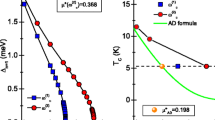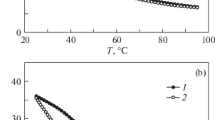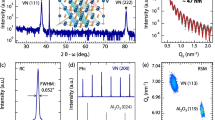Abstract
The critical temperature of the surface superconductivity in vanadium (Tcs) is found to be 0.04 K higher than the critical temperature of its volume superconductivity (Tcv). Surface superconductivity persistent currents can effectively trap a magnetic flux. The critical current density of the surface superconductivity is estimated at js = 5 × 106 A/cm2 at T = Tcv.
Similar content being viewed by others
INTRODUCTION
The phenomenon of surface superconductivity has long been known, and its theoretical description, given by de Gennes [1], can be found in almost all books devoted to superconductivity. Here, the coincidence of the volume and surface critical temperatures is taken as a postulate. In addition, such questions as the possibility of magnetic flux trapping by surface superconductivity currents and the critical values of these currents are not discussed anywhere.
Surprisingly few papers have been devoted to studying the superconductivity in vanadium. As an example, we note works [2, 3]. As follows from them, vanadium is a type II superconductor with a Ginzburg–Landau parameter of 1.8 [2] or 0.78 [3]. The critical temperature of vanadium is considered to be Tc = 5.45 K.
The superconducting properties of small vanadium particles and films were studied in, e.g., [4, 5].
The aim of this work is to perform a magnetometric study of the superconducting properties of vanadium near its critical temperature.
EXPERIMENTAL
The vanadium sample to be studied had a spherical shape. It was prepared as follows: a cube was first cut from an initial single crystal and was then ground in a vortex air cell, the inner surface of which was lined with fine sandpaper. The damaged surface layer was removed by chemical etching. The vanadium sample diameter was 1 mm.
This sample shape exactly corresponds to a demagnetizing factor of 1/3. In addition, a sphere is very attractive for noncontact magnetometric studies of surface superconductivity: an applied magnetic field is tangent to the surface of the ball at the “equator” of the sample, all points of which are equivalent to each other. Accordingly, clearly localized closed superconducting circuits generated by surface superconductivity should be expected near the equator.
The measurements were carried out with a SQUID magnetometer [6], which allowed us to record M(H) dependences (magnetic moment of the sample versus the applied magnetic field) at a fixed temperature and M(T) dependences at a fixed applied field.
The (H, T) field of research was limited to the finite dynamic range of the magnetic moment recording system. The ratio (maximum recorded signal)/(noise level) was on the order of 107.
The measurements were carried out at temperatures from 4.2 K to the temperatures approximately 1 K higher than the critical temperatures of vanadium. The temperature was determined from the readings of a copper–gold thermocouple, and small temperature shifts were determined from a change in the heater operating conditions.
The setup was additionally calibrated against the magnetic moment of a single turn, through which a well-controlled current was passed. A turn of a 0.01‑mm copper wire was wound on a quartz frame 1.6 mm in diameter.
RESULTS AND DISCUSSION
At low temperatures, within the available measurement range –2 Oe < H < 2 Oe, the measured M(H) dependences turned out to be linear and completely reversible, without any signs of hysteresis.
At slightly higher temperatures, near the critical one, the initial segment of the M(H) dependences remains exactly the same as at low temperatures, completely reversible. However, when the applied field grows further, the M(H) dependences deviate from linear ones, which indicates that a magnetic field begins to penetrate the sample (Fig. 1a). The experimental curve shown in Fig. 1 and similar curves were recorded after preliminary heating of the sample to its normal state and cooling to a given temperature at H = 0.
(a) Initial part of the M(H) dependence recorded when the field applied to the sample is swept from zero. The temperature is close to critical. (dashed line) Measurements at low temperatures. (inset) Numerical differentiation. (b) Evolution of hysteresis loops when the critical temperature is approached. The arrows indicate the applied field direction.
Since the demagnetizing factor of the sample is exactly known, it seems reasonable to relate the observed inflection-point field H* to the critical field of volume superconductivity Hc1 = (3/2)H*.
When the applied field is swept to values higher than field H*, the dependences M(H) become hysteretic (Fig. 1b). Usually, this behavior of the M(H) dependences is associated with the manifestation of pinning.
Due to the rigid relation between Hc1 and H*, the temperature dependence of the critical field H*(T) allows us to determine the critical temperature for the sample volume Tcv, as shown in the right part of Fig. 2.
Figure 2 also shows the magnetic moment of the sample measured upon cooling in a dc magnetic field and without it. It should be emphasized that, in both cases, no noticeable magnetic moment appears up to temperature Tcv. Therefore, there is every reason to state that no superconductivity exists in the sample volume at temperatures above Tcv.
An unexpected result appears when an applied field is swept if the temperature exceeds Tcv. The M(H) dependences remain hysteretic. The presence of hysteresis in the M(H) dependences clearly indicates that the sample can trap a magnetic flux even at temperatures higher than Tcv. It is also important that when the field sweep is stopped, the magnetic moment remains unchanged; i.e., the current induced by a changing applied field does not attenuate.
In addition to recording minor loops, we were able to show the existence of a major loop, which is approached by the M(H) dependences at a sufficiently wide field sweep range (Fig. 3a). This major loop is the same regardless of whether the sample was preliminarily cooled in a zero or finite field.
As the temperature increases, the major hysteresis loop amplitude decreases and all characteristic features of the loop are completely retained (see Fig. 3b).
The fundamental difference between the obtained M(H) dependences in the major hysteresis loop and the similar dependences caused by pinning is that the extreme magnetic moments are observed before rather than after an applied field passes through zero. Another important feature of the major M(H) loop is its symmetry. Both the upper and lower branches of the loop are even with respect to the field of the extremum magnetic moment.
Figure 4 shows the temperature dependences of the magnetic moment amplitude in the major hysteresis loop. At temperatures above Tcs, the M(H) dependences become linear and completely reversible. The state of the sample under these conditions should be considered normal. The difference between temperatures Tcs and Tcv was 0.04 K.
The recorded dependences of the magnetic moment of the sample and the characteristic rhomboidal shape of the major hysteresis loop unambiguously indicate the existence of a thin superconducting circuit in the sample at temperatures between Tcv and Tcs. This circuit can only be located on the sample surface. Moreover, it is thought to be localized near the equator of the sample, since the normal component of the magnetic field suppresses surface superconductivity. Thus, the diameter of the magnetic-flux-trapping circuit is equal to the diameter of the sample. This conclusion is also confirmed by the fact that the derivative dM/dH is comparable with the magnetic susceptibility of the sample in the obviously superconducting state at the initial stage of recording a minor loop, immediately after changing the direction of applied field sweep.
Hence, using the performed calibrations, we can estimate that critical current Ic (loop current in the major hysteresis loop) at Tcv can reach 50 mA. The coordinate axis in units of current is also shown on the right side of Fig. 4.
The shift of the extreme values of the magnetic moment in the major hysteresis loop relative to the zero field is caused by the current induced in the circuit. The field of this current outside the sample is directed against the swept field; therefore, zero values on the surface are reached before the applied field becomes zero. In the experiments, the shift of maximum M relative to the applied zero field was approximately 1 Oe (see Fig. 3). This allows us to estimate the length of the superconducting current-carrying circuit along the meridian. It was 0.2 mm (at a current of 50 mA, a field of 1 Oe appears on the wire surface at a wire diameter of 0.2 mm).
Assuming that the detected surface currents flow in a layer on the order of the penetration depth (500–1000 Å), we can also estimate the average current density in the circuit, jc = 5 × 106 A/cm2 at T = Tcv. This current density, which exceeds the parameters of technical superconductors at the lowest temperatures, is achieved only 1% below the critical temperature of the transition of the sample surface into a superconducting state. Therefore, the characteristic scale for the detected loop currents of surface superconductivity is represented by the depairing currents.
It should also be noted that this estimate is in complete agreement with the results of computer simulation [7].
CONCLUSIONS
Thus, our experimental results demonstrate that surface superconductivity cannot be considered a negligible “weak” effect. Surface superconductivity noticeably shields an applied magnetic field, and the density of the detected persistent electric currents excited in the surface layer is comparable with the depairing current density of volume superconductivity.
We also showed that there is a finite temperature range in which only surface superconductivity occurs. Upon cooling, surface superconductivity appears first at temperature Tcs and volume superconductivity appears only upon further cooling to temperatures lower than Tcv. A similar situation was observed earlier in lead samples [8].
Our experimental results demonstrate that surface superconductivity should be considered as an independent phenomenon, i.e., superconductivity in a “two-dimensional” system.
REFERENCES
P. G. de Gennes, Superconductivity of Metals and Alloys (Bengamin, New York, 1966).
R. B. Martin and A. C. Rose-Ines, Phys. Lett. 19, 467 (1965).
H. W. Weber, E. Moser, and E. Seidl, Phys. B (Amsterdam, Neth.) 107, 295 (1981).
Yu. G. Morozov, Sov. Phys. Solid State 22, 113 (1980).
V. M. Kuz’menko et al., Sov. Phys. JETP 47, 1081 (1978).
I. N. Khlyustikov, Prib. Tekh. Eksp., No. 6, 167 (1984).
E. R. Podolyak, J. Exp. Theor. Phys. 126, 389 (2018).
I. N. Khlyustikov, J. Exp. Theor. Phys. 122, 328 (2016).
ACKNOWLEDGMENTS
I am grateful to E.R. Podolyak, E.G. Nikolaev, and V.I. Marchenko for numerous extremely useful discussions of the results of this work.
Author information
Authors and Affiliations
Corresponding author
Additional information
Translated by K. Shakhlevich
Rights and permissions
Open Access. This article is distributed under the terms of the Creative Commons Attribution 4.0 International Public License (http://creativecommons.org/licenses/by/4.0/), which permits unrestricted use, distribution, and reproduction in any medium provided you give appropriate credit to the original author(s) and the source, provide a link to the Creative Commons license, and indicate if changes were made.
About this article
Cite this article
Khlyustikov, I.N. Surface Superconductivity of Vanadium. J. Exp. Theor. Phys. 132, 453–456 (2021). https://doi.org/10.1134/S1063776121030043
Received:
Revised:
Accepted:
Published:
Issue Date:
DOI: https://doi.org/10.1134/S1063776121030043








